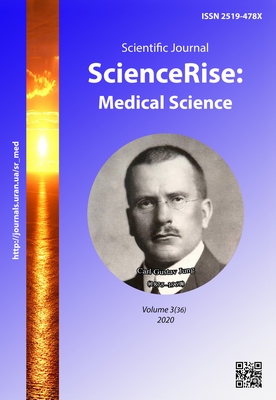Long-term results of combined treatment of triple-negative breast cancer
DOI:
https://doi.org/10.15587/2519-4798.2020.203371Keywords:
triple negative breast cancer, radical surgery, combination treatment, long-term outcome, neoadjuvant chemotherapyAbstract
The most dangerous immunohistochemical type of breast cancer is the triple-negative type. This subtype is detected in 10-20 % of breast cancer cases and is characterized by an aggressive clinical course with high proliferative activity and growth rate, which leads to more active surgical tactics and systemic treatment.
The aim of the study was to study the long-term results of the combined treatment of triple-negative type of breast cancer in comparison with other immunohistochemical types.
Materials and methods. The treatment results of 140 women with breast cancer who underwent radical surgery and were available for contact after 6 months and more after the operation were analyzed depending on the initial clinical and pathological parameters and treatment features using the methods of descriptive statistics, χ2 criterion and correlation analysis, survival tables and the Kaplan-Meier method.
Results. During the analyzed period, distant metastases were detected in 5 (3.6 %), locoregional recurrence in 15 (10.7 %), 12 (8.6 %) patients died. Long-term results with triple-negative type of breast cancer are worse than with luminal forms. A significant dependence of survival on neoadjuvant chemotherapy was revealed. Radiation therapy, the volume of surgery (radical resection or radical mastectomy), breast reconstruction did not significantly affect the long-term result of treatment.
Conclusion. Triple-negative type of breast cancer has the worst long-term results with an increase in the frequency of distant and locoregional metastases and a decrease in overall and relapse-free survival compared with luminal types. After neoadjuvant chemotherapy, the frequency of locoregional relapses decreases and the life expectancy of patients increases
References
- Ragimzade, S. E. (2017). Rak molochnoi zhelezy: epidemiologiya, faktory riska, patogenez, diagnostika, prognoz. Mіzhnarodnii medichnii zhurnal, 2, 60–64.
- Senkus, E., Kyriakides, S., Ohno, S., Penault-Llorca, F., Poortmans, P., Rutgers, E. et. al. (2015). Primary breast cancer: ESMO Clinical Practice Guidelines for diagnosis, treatment and follow-up. Annals of Oncology, 26, v8–v30. doi: http://doi.org/10.1093/annonc/mdv298
- Wang, Q., Xu, M., Sun, Y., Chen, J., Chen, C., Qian, C. et. al. (2019). Gene Expression Profiling for Diagnosis of Triple-Negative Breast Cancer: A Multicenter, Retrospective Cohort Study. Frontiers in Oncology, 9. doi: http://doi.org/10.3389/fonc.2019.00354
- Fayaz, S., Demian, G. A., El-Sherify, M., Eissa, H., Aziz, M., Abuzallouf, S. (2019). Triple negative breast cancer: 10-year survival update of the applied treatment strategy in Kuwait. Gulf Journal of Oncology, 1 (29), 53–59.
- Moran, M. S. (2014). Should Triple-Negative Breast Cancer (TNBC) Subtype Affect Local-Regional Therapy Decision Making? American Society of Clinical Oncology Educational Book, 34, e32–e36. doi: http://doi.org/10.14694/edbook_am.2014.34.e32
- James, M., Dixit, A., Robinson, B., Frampton, C., Davey, V. (2019). Outcomes for Patients with Non-metastatic Triple-negative Breast Cancer in New Zealand. Clinical Oncology, 31 (1), 17–24. doi: http://doi.org/10.1016/j.clon.2018.09.006
- Sharma, P. (2016). Biology and Management of Patients With Triple‐Negative Breast Cancer. The Oncologist, 21 (9), 1050–1062. doi: http://doi.org/10.1634/theoncologist.2016-0067
- Zikiryakhodzhayev, A. D., Rasskazova, E. A., Tukmakov, A. Y., Shirokikh, I. M. (2019). Relapses after radical subcutaneous/skin-sparing mastectomy with simultaneous reconstruction in breast cancer. Research’n Practical Medicine Journal, 6 (1), 33–40. doi: http://doi.org/10.17709/2409-2231-2019-6-1-3
- Chen, Q.-X., Wang, X.-X., Lin, P.-Y., Zhang, J., Li, J.-J., Song, C.-G., Shao, Z.-M. (2016). The different outcomes between breast-conserving surgery and mastectomy in triple-negative breast cancer: a population-based study from the SEER 18 database. Oncotarget, 8 (3), 4773–4780. doi: http://doi.org/10.18632/oncotarget.13976
- Holleczek, B., Stegmaier, C., Radosa, J. C., Solomayer, E.-F., Brenner, H. (2019). Risk of loco-regional recurrence and distant metastases of patients with invasive breast cancer up to ten years after diagnosis – results from a registry-based study from Germany. BMC Cancer, 19 (1). doi: http://doi.org/10.1186/s12885-019-5710-5
- McGuire, A., Lowery, A. J., Kell, M. R., Kerin, M. J., Sweeney, K. J. (2017). Locoregional Recurrence Following Breast Cancer Surgery in the Trastuzumab Era: A Systematic Review by Subtype. Annals of Surgical Oncology, 24 (11), 3124–3132. doi: http://doi.org/10.1245/s10434-017-6021-1
Downloads
Published
How to Cite
Issue
Section
License
Copyright (c) 2020 Yuriy Vinnyk, Vadim Vlasenko, Anna Baranova

This work is licensed under a Creative Commons Attribution 4.0 International License.
Our journal abides by the Creative Commons CC BY copyright rights and permissions for open access journals.
Authors, who are published in this journal, agree to the following conditions:
1. The authors reserve the right to authorship of the work and pass the first publication right of this work to the journal under the terms of a Creative Commons CC BY, which allows others to freely distribute the published research with the obligatory reference to the authors of the original work and the first publication of the work in this journal.
2. The authors have the right to conclude separate supplement agreements that relate to non-exclusive work distribution in the form in which it has been published by the journal (for example, to upload the work to the online storage of the journal or publish it as part of a monograph), provided that the reference to the first publication of the work in this journal is included.









